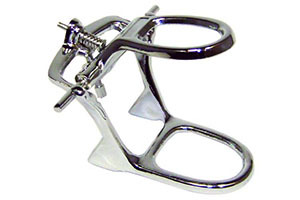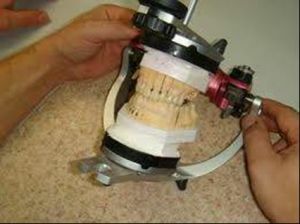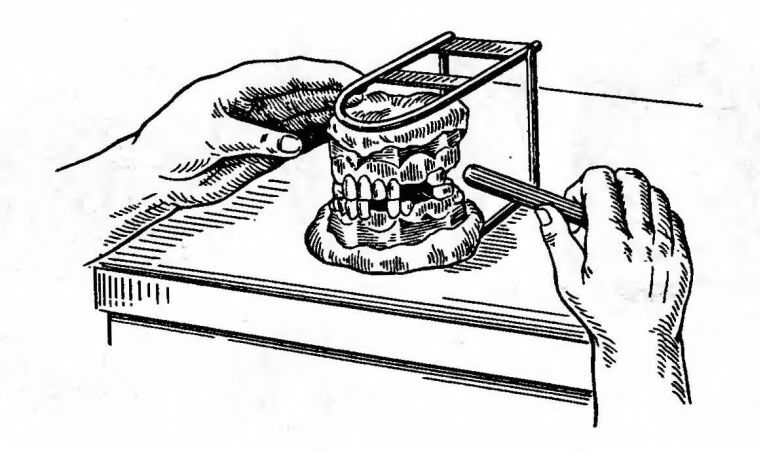 In orthopedic dentistry, an important laboratory stage is the verification of the manufactured structure. It is very important to assess its clamping and the possibility of implementing all kinds of occlusal movements. To this end, a dental occludator is used.
In orthopedic dentistry, an important laboratory stage is the verification of the manufactured structure. It is very important to assess its clamping and the possibility of implementing all kinds of occlusal movements. To this end, a dental occludator is used.
This is a special device used in the process of creating orthopedic structures. It has gypsum models of jaws and reproduces a number of chewing movements.
The device includes 2 arcs: upper and lower. They are interconnected by a transverse rod. If necessary, it can be removed.
The occludator is plastering finished models. The upper model, respectively, is fixed to the upper arc, and the lower one to the lower one.
This device is used for the manufacture of all types of orthopedic structures. It reproduces the movements of the jaws only in the vertical plane. With this device, the central ratio of the jaws and the height of the bite is determined.
Contents
- Classification of
- devices Hinged device and cast
- Vasilyev's apparatus
- How does it work?
- Comparison with articulator
Classification of
devices All devices differ in size. They can be:
- large;
- average;
- are small.
The main classification is based on design features. Allocate occluders:
- wire;
- cast;
- universal device of Vasiliev.
Hinged and cast
A conventional wire hinge type occluder consists of 2 arcs. One of them, most often it's the bottom one, bends at an angle of 100-110  degrees.
degrees.
There is a hinge-type connection between the arcs. To record the distance between the alveolar processes in the position of the central occlusion, a screw or a rod having a vertical direction is used. In the process of using the device it is important not to forget about this feature. It is recommended that the models be smoothly and softly closed so as not to affect the pre-determined bite height. Turning the rod allows you to change it.
Sometimes the rod is not used. This occurs in situations where the patient retains antagonist teeth. They are able to maintain the necessary height of the bite, which does not need to be determined anew.
Molded occluders are distinguished by the fact that their arcs are not made of wire, but completely cast from metal.
Apparatus Vasileva
Separately it is necessary to allocate a universal occludator, which was modified by Vasiliev. Just like the conventional hinge, it includes the upper and lower arcs. In this case, they are not made of wire, but of metal plates. They are soldered to oval rings with holes for studs. They are responsible for fixing plastered models.
At the rear of the lower arc, there are posts with holes for the rod. It is he who connects two arcs to each other.
On the lower arc there are grooves for the pin. You can find them on the front. The pin is responsible for keeping the height in the position of the central occlusion.
On the upper arc there are hinges for the hinge rod. In its front part there is a hinge, by means of which a pin is inserted, which is inserted into the recess on the lower arc. The articulation of the arc and the pin allows it to be pulled forward if necessary.

How does it work?
Method of use:
- installation of models in the device using gypsum;
- transfer of data on occlusion height and jaw position in the position of central occlusion;
- Verification of vertical movements, if any violations occur, they are corrected.
Comparison with articulator
Of course, the occludator is much easier to use than the articulator. However, its main drawback is the ability to reproduce only vertical movements. In turn, the articulator is able to simulate movements in all directions.

This is most important in prosthetics of patients with complete loss of teeth. The impossibility of evaluating the horizontal movements does not allow to check the prostheses in all phases of displacement of the lower jaw relative to the upper one.
The doctor is under an additional burden to check the prosthesis during delivery. It is necessary to check again the clamping and grinding of the mounds and cutting edges of the artificial teeth, which interfere with the normal movements of the jaws.
The articulator allows you to fully appreciate the quality of the prosthesis before the final processing of the structure. The technician has the opportunity to see the flaws in the closing on all sides, which is much more difficult to do in the oral cavity.
Almost all doctors and dental technicians have already refused to use the occludator. It is replaced by modern models of articulators, which allow creating better prostheses.
Almost all designs should be checked at intermediate stages. This can not be done without a full and comprehensive evaluation. Its main stage is the precise definition of all occlusal relationships of the jaws.
